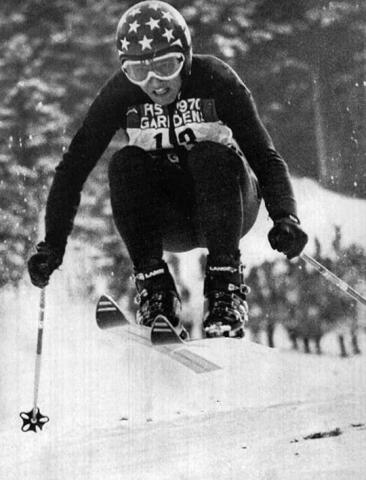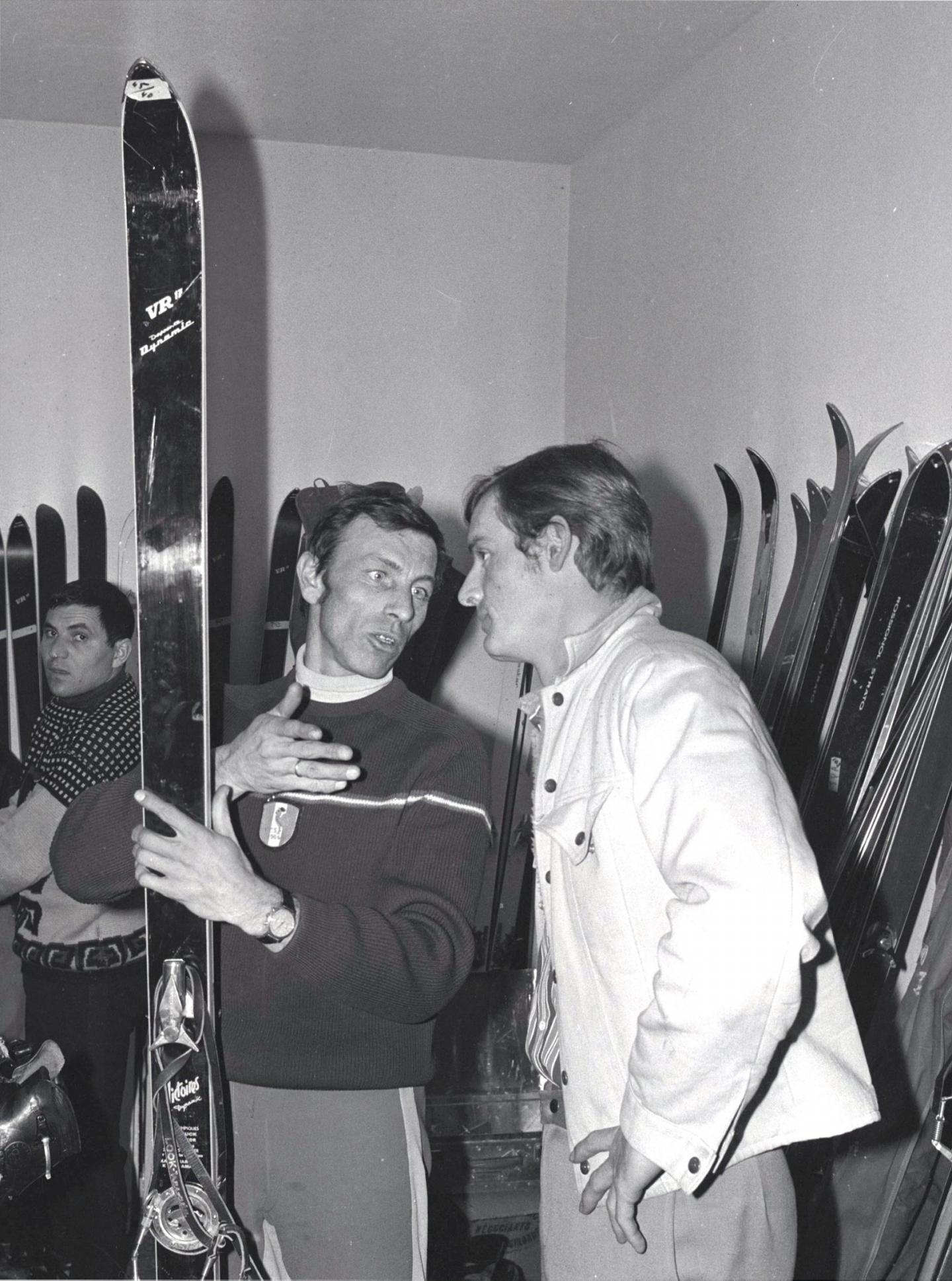
By Seth Masia
The VR17, engineered for French ski racers, was imitated by ski factories around the world.
From the January-February 2022 issue
The Dynamic VR17 remains legendary, and for good reason. With its hickory core, fiberglass torsion-box construction, “cracked” flexible edge, stiff tail and rear-waisted sidecut, the ski set the standard for slalom performance beginning in 1966. For the next two decades most of the slalom racing skis built around the world copied the VR17’s design details. VR17 clones, exact or approximate, were made by Dynastar, Lange, Head, Durafiber, K2, Völkl, Fischer, Atomic, Blizzard, Hexcel, Olin, Elan and possibly others.
Photo top: Billy Kidd en route to the 1970 combined world championship, on the VR17.
The ski was developed in the tiny agricultural commune of Sillans en Isère, population about 830. Sillans lies about 10 miles west of Voiron, where Abel Rossignol had been manufacturing skis since 1907. Two significant workshops comprised most of what might be called industry in Sillans. The Carrier family made shoes for farmers and hunters, and right next door the Michal family made wooden shuttles for the silk factories of Lyons and, occasionally, furniture.

Carrier out for a stroll. Courtesy J-C Verhilac.
Marcel Carrier, representing the third generation to manage the shoe factory, ran off at age 17 to fight in World War I. Returning in 1918 he was enamored of skiing and started to make ski boots. In 1930, with Alpine racing just emerging as a high-speed spectator sport (see “Alpine Revolution,” January–February 2021), Carrier recognized that the new Kandahar cable bindings, which fastened down the heel, would need stiffer, more specialized ski boots—and he made them under a new label, Le Trappeur. In 1931 he approached 19-year-old Emile Allais, the rising star of French ski racing, who agreed to use the new boots. The following year Carrier began marketing the boot in North America; the success of the brand helped Sillans weather the Depression.
After Allais visited the shop in 1931, Carrier popped next door and asked his close friend Paul Michal, then training to take over the family woodworking shop, to make some skis. Michal knew little about skiing, but local ski champion André Jamet loaned him a pair of Norwegian skis to copy. Michal found making skis far more interesting than turning out shuttles and bobbins (just as Abel Rossignol had done a generation earlier). With his brother-in-law, Jean Berthet, in 1934 he began selling Alpine skis under the brand name Skis M.B. (Michal and Berthet). In 1937, the brand name became Nivôse. Derived from the Latin word for snowy, it was the name of his distributor, a new ski-clothing company in Lyon.
After 1934, with the introduction of laminated skis, ski-making on an industrial scale became an innovative business. Rather than license the Splitkein patent for laminated skis, Dynamic continued to carve skis from single planks, in hickory or ash. In 1936, in order to more accurately pair skis, Michal invented a “dynamometer,” a device to test the flex of each ski before the final varnish sealed the matching serial numbers. And he rebranded his skis as Nivôse -Dynamic, for “DYNAmometer” and “MIChal.” It was the first Alpine Olympic year.

Dynamic K, with Cellolix base and
channels for the continuous edge. From
George Joubert's book Modern Technique,
1957.
During World War II, ski production ceased as the Nazis forced Michal to make wooden shoe-soles for export to Germany. After Liberation in August 1944, he was reluctant to resume making the old pre-war ski designs. Michal resumed production, now building skis with 24 hardwood laminations. (Berthet remained a partner but left Sillans to run a factory in Reims). In 1946, Michal hired downhill world champion James Couttet as ski tester and technical adviser.
Michal and Couttet hoped to improve glide speed, and among other solutions, Michal sought out Xavier Convert, who manufactured celluloid plastic for combs. Convert was trying to revive business for his factory in Oyonnax, which today is the center of the French plastics industry. He proposed to create solid celluloid bases for skis. Celluloid would make a tough and permanently waterproof base that should also glide well.
Little was known about how to make a ski glide faster, other than to paint on a slick waterproof lacquer and hit the right wax (see “Walter Kofler Invents the Polyethylene Base,” November–December 2021). Insulating bases did work better than heat-conducting surfaces like aluminum and steel, however, so a plastic armor plate showed promise. The new “Cellolix” base offered an advantage to racers, especially in combination with a new Michal invention: the hidden, low-drag continuous L-section edge. Michal applied for a patent on the edge in 1949 and built the Dynamic K race ski with it beginning around 1950. Recreational skiers, however, didn’t see a reason to pay extra for that edge, and eventually he let the patent lapse. Truth be told, Michal wasn’t interested in selling recreational skis. If a ski worked for racers, he claimed, it should work for every skier.
Michal thought of himself as an artisan in wood, tweaking his skis to meet the needs of the ski racers who came to Sillans to talk to him. In the years before bombed-out Austrian factories rebuilt, Michal equipped Austrian as well as French racers. By 1950, dozens of top racers from all the Alpine nations rode to victory on Dynamic’s K model, with 24 laminates of hickory, continuous edges and Cellolix bottoms. The list included Othmar Schneider, Anderl Molterer, James Couttet, François Bonlieu and Charles Bozon. Then in 1954 Austrian and Swiss skiers got Kofix polyethylene bases and Dynamic lost its speed advantage. Dynamic finally offered polyethylene as an option on the ash Slalom Leger and hickory Slalom Géant in 1959. Michal called the new base Polyrex.

at the 1960 Olympics, on wooden
Dynamics. Two years later he won the
slalom world championship. Club des Sports
Chamonix-Mont Blanc
By 1950, metal skis were edging into the market, in part because celluloid had solved the problem of bare metal’s poor glide. Michal was never a fan of metal in skis, and around 1955 he turned his attention to fiberglass, partly at the behest of Claude Joseph, who manufactured polyester resin and corrugated fiberglass panels. Progress was slow, based on trial-and-error tests with racers, notably Olympic medalist Charles Bozon. In 1960 Michal realized that he needed a more systematic approach to product development. He took a number of structural engineering courses at the University of Grenoble, focusing on spring rates and inertia. He also hired Michel Arpin, the racer who had become Jean-Claude Killy’s mentor and technician.
In 1963 the team built the glass-wrapped polyester-resin/fiberglass Compound RG5 racing ski, built by Dynamic in Sillans. Joseph founded Dynastar, in Sallanches, to make the consumer-sales version. The name meant resin-glass, five years in development.
Dynamic and Dynastar parted ways. In 1964, Michal introduced the VR7 as Dynamic’s new race ski, largely of Bozon’s design. The name meant Verre Resine (resin glass), seven years in development.That summer, Bozon was one of 14 climbers killed in an avalanche above Chamonix. Michal’s son Jean joined the company and created its first logo, the familiar double-bar chevron.
Arpin, with Killy’s input, created the VR17 to help racers take full advantage of the new forward-canted boots and avalement technique (see “Le Trappeur Elite” and “Avalement,” July–August 2021). The VR17 moved the waist back from the ball of the foot to the heel, because that was where French racers were driving the turn, and for the same reason had a stiffer tail. The ski was also built with tough epoxy rather than polyester resin, and – perhaps most important -- had a new super-flexible “cracked” edge—one continuous piece of steel with segments engineered into the visible part of the L-shape. This construction took the vibrational frequency of steel out of the ski’s dynamic behavior, letting the glass-wrapped box dampen chatter at its natural rate. Because the edge no longer contributed to lengthwise flex, the ski was made thicker, which significantly increased the torsional stiffness. The segmented edge also cut into ice like a serrated knife.

among Dynamic's race stock VR17
inventory. Private collection.
In 1966 Arpin dropped off the ski team to work full time building skis for Killy and a few more top French skiers, at a time when the team, and Killy in particular, dominated Alpine racing season after season. Racers weren’t allowed to endorse products directly, so French skiers were free to use Rossignols or VR17s, depending on which they felt would be fastest on the day’s course conditions.
In 1963, Michal turned over day-to-day operations to his son Jean, and served as fully involved chairman. He still focused on race skis, built by a small, elite crew headed by Paul Serra. But Michal, at heart an artisanal woodworker, regarded every Dynamic ski as a custom build for some racer, somewhere. The torsion box had been a genius idea: fiberglass wrapped around the core eliminated any chance of structural delamination, and the glass fibers could be spiral-wrapped to fine-tune the balance between torsional and beam flex. Racers like Killy and Billy Kidd won races and championships on their Dynamics, and other factories imitated the design.
Paul Michal retired for good in 1967. Under Jean Michal’s management, sales boomed. In 1969, Bob Lange signed a contract to import Dynamic to North America and even to build VR17s in his new factory in Broomfield, Colorado.
The market became increasingly competitive, and rival brands sold many thousands of recreational skis to subsidize their custom-built race models. Paul Michal’s assurance that anyone could ski on the VR17 was pure nonsense. The ski required strength, speed and catlike reactions. “It rewards brilliance and punishes mediocrity,” said one wag at the time.
But expert skiers around the world wanted VR17s, and the factory couldn’t meet demand. U.S. production stopped when Lange lost control of his company in 1973. Ian Ferguson, Lange’s sales manager, noted that manufacturing quality for consumer-market skis deteriorated, at least in the Boulder factory. The assembly process was sloppy, he said. A worker wrapped the core in the requisite layers of fiberglass cloth, soaked it with liquid resin and placed the assembly in the mold. Variations in the resin volume plus wrinkles, folds and air bubbles made the ski’s ultimate flex and strength unpredictable. Pair-matching wasn’t precise, either, because skis were measured for shovel and tail flex but not for full-length flex or torsion.
In 1971, to finance larger production, the partners Paul Michal, Jean Berthet and Marcel Carrier sold a share of the company to an investment group. Within a year, they sold all their shares, leaving the new management company in control. Jean Michal left, in disgust, in 1973.
The fact was that cloned designs from other factories worked just as well and had better quality control. Eventually a mass-production version, the VR27, was marketed worldwide, along with a series of softer recreational skis.
Unable to expand production profitably, the new owners sold the company to Atomic in 1988. Atomic moved production to Austria and closed the Sillans factory in 1994.
Today you can find the Dynamic VR17 brand on boutique skis made in Switzerland. As for Paul Michal, he remained innovative, filing for a patent as late as 1975. He died in 1983.
Sources for this story include Jean Michal, Nicole Chabah: Sillans, petite cite de grandes aventures (Editions Alzieu 2000); Juliette Barthaux, L’innovation dans l’histoire du ski alpin (unpublished master’s thesis, 1987); and interviews with Michel Arpin, Ian Ferguson and Maurice Woehrlé. Many thanks to Albert Parolai and Jean-Charles Verhilac for research assistance.
Seth Masia, president of ISHA, wrote about Kofix in the last issue of Skiing History.
